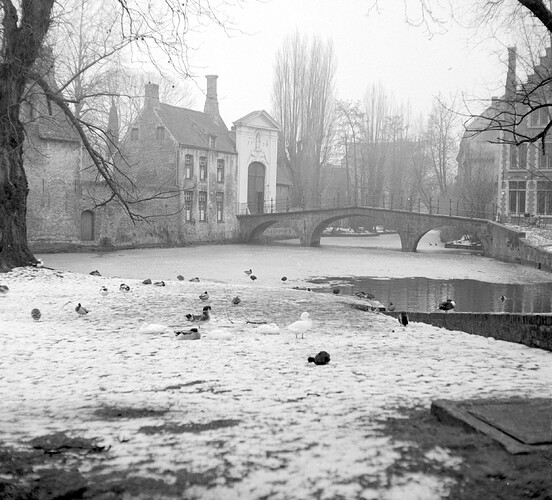I like all these shots, even with the tree for the last one.
Here an old picture (1994) of Bruges, in the same district, shot with a 6x6 and scanned
That’s the magic of analog photography - good planning before you take the shot and no need for pixel peeping afterwards. Is this presentation achievable with film pack? There remains a noticeable difference between monochrome analog and monochrome digital, although both processes have their advantages. Monochrome and color are wonderfully contrasted in this thread.
Are there any websites that illustrate this “noticeable difference”?
I’ll do a search later tonight or tomorrow. I suspect the latest digital cameras would struggle to keep up with a 4x5 or 8x10 view camera, but maybe then it comes down to the lenses used on each. I’ve wondered about this for ages, but it’s just curiosity.
How might the above photo from @BenoitG have differed if he went to the same spot and shot it with a 50 megapixel Nikon D850, under the same conditions? Are we referring to “detail” or something else?
On the other hand… for those of us who photograph ephemeral subjects it’s hard to beat digital. Yes one can plan to a certain extent, but when you’re walking down a path and see an interesting bird, you have no control over when or where you see it, nor how long it will stay in one place. A well practised film photographer can do well even in this circumstance, but many of us are not well practised to a sufficient level. One practice I use often is “shoot first, then try to get closer, then repeat.” That gets mighty expensive with a film camera.
And surely the film?
I think the various aspects are now somewhat beyond the scope of the thread, which I don’t want to hijack. Perhaps this topic could be continued in a separate thread. @mwsilvers It might be interesting to convert one of the digital color photos to monochrome in order to be able to make comparisons, photo 1 for example.
Yes, yes, yes! Planning is key and, due to the cost of film, it is something that we do a lot more of before blowing €10+ on a single sheet of LF film.
If I dare say, only if the photographer doesn’t know what they are doing ![]() I have mentioned before - we do both and have the results, printed large, on our walls. Visiting photographer friends can’t tell the difference. Or were you talking about the attitudes of those digital photographers who don’t take the time and effort that a film photographer would?
I have mentioned before - we do both and have the results, printed large, on our walls. Visiting photographer friends can’t tell the difference. Or were you talking about the attitudes of those digital photographers who don’t take the time and effort that a film photographer would?
Some might exist but, as I just said, there shouldn’t be in the hands of a skilled photographer.
Sir Don McCullin said, in one interview, that he didn’t like digital because it was too easy to fake and move stuff, but he uses digital himself in the same disciplined way that he uses film.
I especially like this extract…
Working with film in the past, you had to limit exposures. Do you still work in the same way?
“I’d have to honestly say no. I know I’ve probably got several hundred opportunities in a memory card, so there’s a tendency to be extravagant and wasteful. In the old days, because I knew the limitations of exposures on a 35mm roll of film, I used to think consciously every time I pressed the button. Without boasting, I have great discipline in my photography. I was never one who squandered film. When motor-winders came into the fray and I was in a place like Vietnam, where they would have been very useful, I never used them. I was always hand-cranking my frames.”
As I have proven many times, my D850, combined with PhotoLab and Topaz and my Canon Pro-1000 printer, are well capable of making extraordinarily superb, large prints that stand up to every bit as much scrutiny as my those taken with my Ebony 5"x4".
Using the same care at the time of shooting, planning for the best RAW file to give the best print, there is no reason why it should appear any different.
Scanning a 5"x4" negative gives a 12,000px x 9,600px file.
A 5:4 ratio image taken on the D850 gives a 6,880px x 5,504px file. Pass the resulting file through Topaz and you easily get a 2x enlargement without degradation.
Differences between digital and film are always down to the photographer and the person doing the printing. A digital image can be made to look totally film-like in the right hands.
Indeed. Which is why I couldn’t do the work I do without FilmPack’s excellent emulations. I was so relieved to find the Fuji Acros 100 emulation gives me virtually the same look and feel as the film I love and have been using for years.
Found this one
https://petapixel.com/2021/08/18/leica-m10-monochrom-vs-kodak-tri-x-400-bw-digital-vs-film/
Same manufacturer, therefore more comparable.
Good idea - people who are unaware of this thread might more likely to find it, if it had its own thread.
